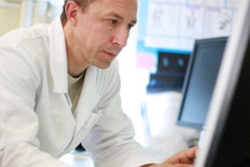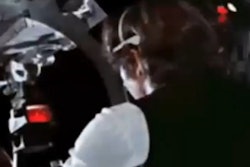
What if you could design the radiology reading room of the future? That's the project underway at Children's Hospital of Philadelphia (CHOP), which is using evidence-based design principles to radically restructure how radiologists work. The goal is a workforce that's more efficient and less stressed out.
CHOP is moving ahead on the reading room project despite delays caused by the COVID-19 pandemic. And administrators and radiologists are finding that the principles behind the new room design are already shifting the way work is conducted at the hospital.
The work is based on the research of a group led by human factors engineer Ethan Larsen, PhD, which published a paper on optimizing the radiology reading room in order to reduce burnout and stress while maximizing well-being and efficiency (JACR, October 13, 2020). Larsen and colleagues proposed a new layout that arranges the reading room into purposeful spaces grounded on evidence-based design, human factors, and the architectural concept of the Eudaimonia Machine.
 Human factors engineer Ethan Larsen, PhD.
Human factors engineer Ethan Larsen, PhD.The concept of the Eudaimonia Machine was developed by Chicago-based architect David Dewane and is framed around Aristotle's concept of Eudaimonia, or flourishing as a human. The Eudaimonia Machine prescribes a precise workspace layout designed to avoid the challenges endemic in many work environments.
Dewane and CHOP partnered to apply these principles to the radiology reading room: At the front, reading room assistants are able to greet healthcare provider teams and provide them with administrative help. Further in the room is a staff lounge for radiologists to socialize and relax.
To the right of the main entrance is a consultation room where radiologists expect to be interrupted from their nonconsultative responsibilities. An office serves as a teaching and collaboration space with acoustic insulation to minimize noise, but it also provides an unobstructed line of sight to foster interaction among radiologists and trainees. The far end of the reading room is the "deep reading room," designated for radiologists who need a distraction-free space to focus and perform their most cognitively demanding work.
The "deep reading room" is a place for "deep work" to occur -- a term coined by computer scientist and author Cal Newport. It describes a "state of maximal focus, creativity, and productivity, which is increasingly difficult to achieve in our distraction-filled world," Larsen and colleagues wrote in their paper.
"We are fully endorsing this Eudaimonia design and we're actually looking at ways to incorporate it in other areas of the hospital ... being able to add those components in some capacity to all of our areas for patient care is going to be important," Larsen said in an interview with AuntMinnie.com.
The pandemic upended CHOP's timeframe for implementing its redesigned reading room, but "while the physical space may not change in the timeline we were hoping, the way the work is done is shifting," he said.
Gone reading
Eudaimonia advocates for clear, physical segmentations of space, but barring the ability to do that, radiologists at CHOP are already declaring, "I'm in deep work mode, don't bother me." In fact, some of the radiologists have started putting up "out of the office" messages when they're on clinical service indicating, "I'm on clinical service. I will respond to nonclinical, relevant messages at ___ time," and they are redirecting people to use the designated secure chat and other clinical methods of contact when it's relevant to a study, according to Larsen.
Regarding the design of the reading room itself, even though the design predates the pandemic, it already facilitates a better degree of separation because each space is segmented. At the same time, changes had to be made in light of the pandemic.
For instance, directional arrows discourage previously free-flowing, multidirectional traffic and keycard access to the radiology room doors have been reactivated to limit the number of people entering and exiting the space. Also, many of CHOP's workstations already had more than 6 ft of separation, and the ones that didn't have almost full-height dividers, which will continue to be used going forward.
"The biggest obstacle has been that we had to just make this mid-course correction to ... adapt to the pandemic," Larsen said. "And while we have not gutted the room, rebuilt the room, or rearranged the furniture, I think we're managing to walk a very fine line of keeping the room safe [and] affording everyone the accommodations they want in that space so that they can minimize interruptions and get the work done in the capacity that they want to."
In hindsight, the peak of the pandemic might have been a great time to gut the reading room because the hospital had a skeleton crew and many people were working from home, Larsen said.
"Unfortunately, everything else going on in the pandemic had everyone so worried about, 'What are we going to be doing moving forward? Let's address our priorities, and the reading room is functional in its present state,' so it wasn't really a high priority to take advantage of, 'no one's in here, let's gut it and rebuild it,' " he added.
The pandemic also afforded CHOP the opportunity to revisit the reading room design to make sure in a postpandemic world that the hospital is able to handle these kinds of emergencies. Plus, new radiology fellows and residents at CHOP may have insights from where they worked previously that could be useful for the new reading room.
"We really do need to just kind of revisit everything and make sure that before we move forward, everyone's on the same page," Larsen said.
He and his colleagues want to make sure the reading room still reflects the desires of the radiologists and that means multiple conversations and interviews with them.
"You engage the people who you're designing for so that they have a say in it, and they can help inform it to be what they want it to be," he said. "So I have high expectations when this room gets redesigned that it will be very well-received by the people who have to work inside it."
Part of incorporating new tweaks into the radiology room redesign is also looking at how work is actually getting done currently. At CHOP, a side entrance to the radiology room is across the hall from the fluoroscopy suite and it's become clear when radiologists are on fluoroscopy service, they want to work in the corner that's closest to that side entrance because they're closer to fluoroscopy.
"Making sure that you incorporate those things people don't necessarily think about, that they like to adapt, and paying attention to the human adaptations can give you a lot of information," Larsen said. "Unless you are asking the exact right questions every time, observations, I feel still even today, are the better ground truth than asking people's opinions exclusively."
The observations, interviews, and feedback from radiologists are sure to create a new sort of reading room that does indeed promote Eudaimonia at work.



















